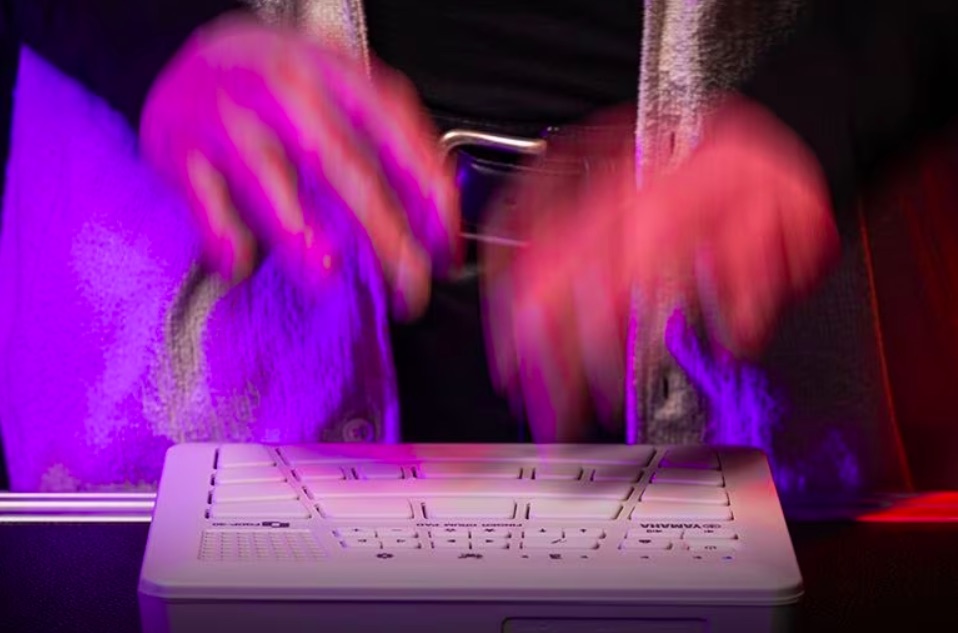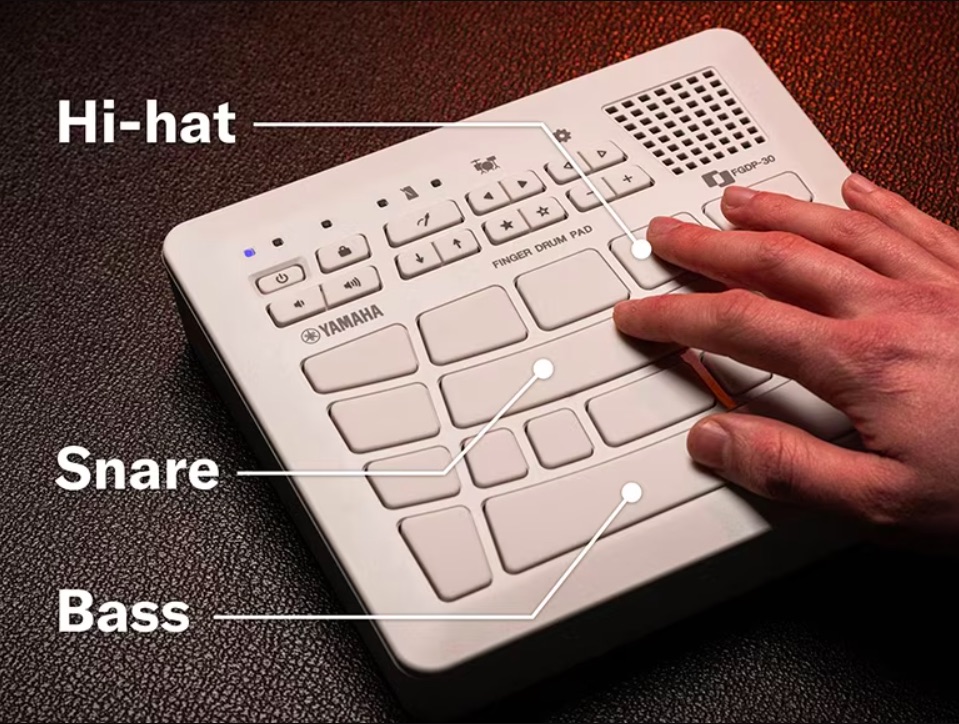The entry-level model in Yamaha’s new finger drumming range offers a fresh take on performing beats. Greg Scarth puts the standalone rhythm unit to the test.

If you had to pick one type of instrument which has been reimagined in more ways than anything else, drums would be an obvious choice. Aside from the traditional acoustic kit, you can take your pick from electronic kits, drum machines, MIDI pads, samplers, MPCs and practice pads. The latest twist on the idea comes in the form of Yamaha’s new FGDP series. (FinGer Drum Pad? We’re not entirely sure what that G’s doing in there either…) The Yamaha FGDP-30 is the smaller and cheaper of the two models, with the larger FGDP-50 including advanced features like RGB pads and a USB slot for flash drives. At £165, the FGDP-30 looks like a real sweet spot in terms of value for money, offering standalone operation, a rechargeable battery and, most importantly, that striking ergonomic pad layout.
Both FGDPs are standalone units, designed to straddle the worlds of fun, immediately accessible toys and solid musical instruments. The FGDP-30 is the entry-level model, but the features are similar across both of the launch models (we’ll return to the benefits of the 50 in due course). While you probably couldn’t accuse the FGDP-30 of being the most beautiful instrument around, there’s a certain utilitarian chic to it, somewhere between an original Akai MPC and a 1990s PC keyboard. What sets it apart from those MPCs and most modern pad controllers is that it doesn’t follow a grid layout. Instead, the pads are arranged in a curved, symmetrical formation with two wider pads placed centrally on the first and third rows up from the bottom. The rationale behind this layout is based on Yamaha’s assertion that the best way to play drum pads is with your dominant hand covering all major elements. Yamaha specifically suggest using your thumb for the kick drum on the wide bottom pad, your index finger for snares on the wide third-row pad, and your middle finger for hi-hats on the top row. From this basic layout, other drums and cymbals are assigned to the smaller pads on most preset kits. Your second hand can then be used to add fills, back beats, 16th notes, double kicks and so on.
In terms of sounds, the FGDP-30 includes 39 preset kits and 1,212 ‘voices’ (i.e. individual drum sounds). These range from acoustic kits, plenty of vintage rock sounds, through to classic analogue drum machine tones and more modern EDM kits. There’s nothing particularly revolutionary about the sounds, but that seems just about right for an instrument like this; you’ve got all the basics covered nicely here, and if you really want to experiment with creating your own sounds then you’ll probably want to step up to the FGDP-50.
Yamaha’s recommendations of how to play the FGDP feel slightly prescriptive at first, but there’s a real sense of logic to it all once you explore the instrument. There are probably hundreds of different ways to play drums using a conventional MPC-style 4×4 square grid of pads, but the ergonomic approach of the FGDP makes a lot of sense, making it easy to play one-handed as well as two-handed. A wide range of drum sounds are placed within reach in a small space, which works particularly well for hits you’re likely to play less often, such as an array of toms or cymbals. Newcomers to finger drumming might find it easier to conform than experienced pad players with years of muscle memory to contend with, but there’s no doubt that the layout and feel of the FGDPs works very well. The feel of the unit is also crucial, of course, and the dynamics of the FGDP pads are intuitive, with nice use of aftertouch to choke sounds.

Adjusting settings on the FGDP-30 works on a couple of different levels. The most basic functions are accessed via the dedicated buttons on the front panel, allowing you to adjust volume, metronome and tempo settings, and kit selection. Deeper menu options require a little bit of digging, but it’s all nicely implemented, allowing you to assign any sound to any pad and create your own custom kits, flip the pads to left-handed mode, or adjust the velocity curve.
Both FGDPs feature a few options designed to help them interact with other hardware and software. They work as simple MIDI controllers, which will surely appeal to anyone who wants to control software using the ergonomic pad layout, but they also offer audio over a built-in USB interface. Yamaha’s Rec’n’Share app is the suggested companion for recording and sharing video performances with high-quality audio recordings, while an aux input allows you to jam along to backing tracks. With all that said, hooking the FGDP-30 up to other equipment does feel like it dilutes the appeal of the unit to an extent. It’s the standalone nature of the FGDP which really defines it, and there’s a lot to be said for simply using it on its own. The built-in speaker is effective thanks to a range of compression and EQ options, while the rechargeable battery is a pleasingly premium inclusion at this price point.
While finger drumming probably represents a pretty small niche in the broader world of music production and electronic instruments, there is significant interest in units like the FGDP-30. Above all else, the FGDP-30 is fun, which is an extremely underrated thing in today’s music tech world. My five-year-old daughter was immediately intrigued by the idea of hammering out noisy beats, which says a lot about the immediacy of the unit, but doesn’t quite explain its depth. This is a device which makes it quick and easy to make beats but also allows you to develop your timing and feel, perhaps to step up to the FGDP-30 or just to enjoy the pleasure of crafting beats. At £165, it feels like a bit of a bargain. Here’s to the next generation of drum pads.
Greg Scarth
More info/buy